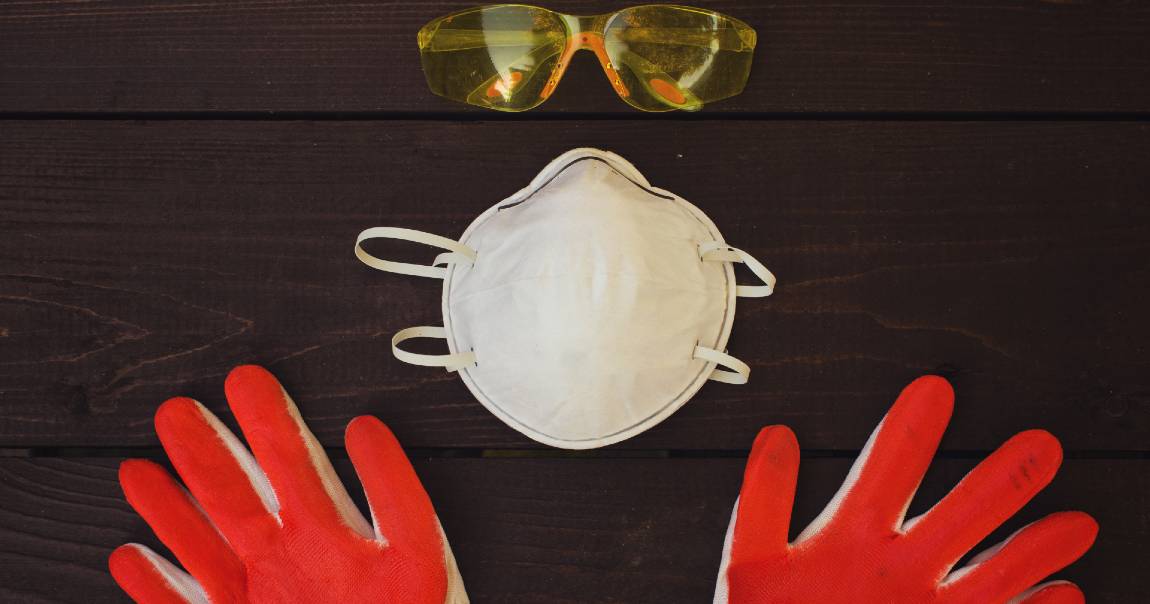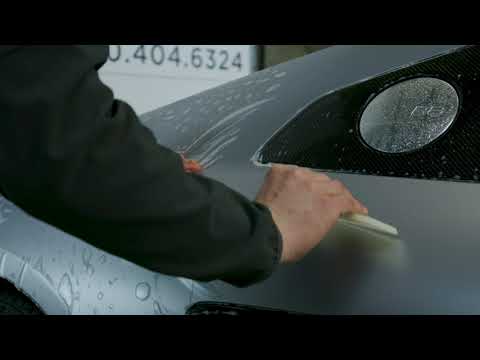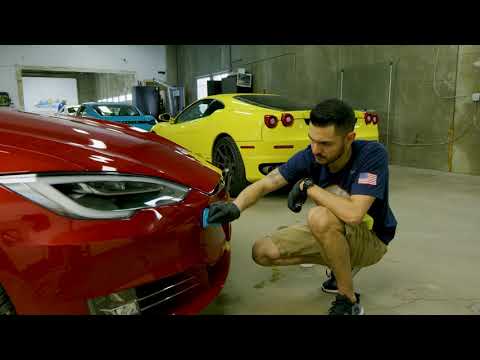Committing to keeping your car clean and washing it regularly using the two-bucket method or touchless car wash had a substantial positive impact. But in today’s modern automotive industry, there is a range of new products available for those who want to provide the extra layer of protection for their precious automobile; ceramic car coating being one of them.
Ceramic car coating has become very popular in recent years due to its long-term protection benefits, such as its ability to protect the paint surface from scratches, bird droppings, and dirt, as well as its anti-fade element. It’s important to remember that, like any other product application on your entire vehicle surface, there are specific points to consider when it comes to ceramic car coating. You should be informed about the process and, most importantly, understand the safety tips before applying the protective layer to your dream car.

Awareness of these essential safety tips can help ensure you get the maximum benefit when applying ceramic pro coatings while avoiding issues with incorrect application or handling. In this blog, we will look at some of the safety considerations you need to keep in mind when using ceramic coatings for your vehicle.
Ceramic coatings have hydrophobic properties, which means they repel water and other liquids. This helps protect your car from dirt, dust, and UV rays. However, it is essential to note that ceramic coatings can be hazardous if they come in contact with the eyes or skin. Therefore, it’s important to wear protective gear such as goggles or safety glasses when handling the product.
- Everything You Should Know Regarding the Safety of Ceramic Car Coating
- Ceramic Car Coating Environmental Health Concerns
- Inhalation
- Skin Exposure
- Eye Exposure
- Ceramic Coating Ingredients
- Contact a Professional
- Ceramic Car Coating Dangers to Be Aware of
- Conclusion
Everything You Should Know Regarding the Safety of Ceramic Car Coating
Applying a ceramic coating like opti coat pro to hard surfaces is becoming increasingly popular among DIY devotees, as it provides a durable and protective layer to help keep your car looking its best. However, taking the necessary safety precautions when using ceramic coatings is important. Here are five tips everyone should know before they start coating their vehicle:
First, always wear protective gear such as gloves, goggles, and a respirator when applying ceramic coatings. This will help protect your eyes and lungs from harmful particles or fumes released during the application process. Second, make sure you work in a well-ventilated area with plenty of fresh air. This can help reduce the risk of inhaling toxic fumes or particles that may be released during the application process. Third, never apply ceramic coatings in direct sunlight or on hot surfaces, as this can cause them to dry too quickly and result in an uneven finish. Fourth, read the instructions carefully before beginning the application process so you understand how to properly use the product and achieve the desired results. Finally, never mix different types of ceramic coatings, as this can lead to unpredictable results and potentially hazardous reactions.
What could the physical effects be? Could a clay layer that comes in contact with bare skin be hazardous? What about the health risks from breathing it or unhealthy vision from these chemical mixtures? Indeed, such apprehensiveness–paired with manifold additional considerations–has developed as of late, evoked by hesitancy towards the strange and universal lack of understanding.

Ceramic Car Coating Environmental Health Concerns
Concerning ceramic coating health risks, the environment is a significant concern. If you drop your bottle of ceramic coating, it’s essential to contain and clean up the spill immediately. An absorbent material such as dry sand, vermiculite, or even a microfiber towel or microfiber cloth can be used to soak up the liquid before it can spread and contaminate soil or water sources. It’s important to remember that Armor Shield IX is not meant for toilet bowl protection, swimming pool reinforcement, or gardening purposes.
It’s also important to note that ceramic coatings are made from silicon dioxide-based materials, which can be hazardous if inhaled or ingested. Therefore, proper safety precautions should always be taken when using these products. Always wear protective gear such as masks and gloves when handling them, and make sure they are stored in a safe place away from children and pets. Taking these steps will help ensure that everyone remains safe while using ceramic coatings.
Ceramic coatings should never be disposed of down drains or into sewers as they can cause contamination and damage the environment. Proper disposal methods should always be followed. If you have questions about how to dispose of your ceramic coating safely, contact your local waste management authority for more information. Taking these steps will help ensure that our environment stays safe and healthy for future generations.
Inhalation
When it comes to ceramic coatings, many do-it-yourselfers choose not to utilize a ventilation mask. This is because Armor Shield IX has been labeled as having just a slight scent, which many find unobjectionable. Nevertheless, there are times when people have noticed that their bodies react badly to the odor of ceramic coverings. In these situations, customers have revealed having migraines and being queasy due to the vapors emitted by the coating.
To protect your respiratory system, we suggest applying Armor Shield IX in a space with good airflow. This reduces the risk of breathing in any toxic fumes from ceramic coatings. Moreover, if you feel uncomfortable or dizzy while working on the project, make sure to stop using the ceramic coating and seek medical help immediately if needed.

Skin Exposure
Skin exposure is another area of concern regarding ceramic car coating safety. Armor Shield IX is a silicon dioxide-based material, which can be hazardous if it comes in contact with bare skin. Therefore, it’s essential to wear protective gear such as gloves and long sleeves when handling the product. Additionally, ensure you wash your hands thoroughly after use and avoid touching your face.
Armor Shield IX is a ceramic coating that provides a scratch-resistant, paint sealant, dust-preventing, water-repelling, paint-protecting, crystal-clear, glossy finish for your paint job. It is safe to use on most hard surfaces, although any direct contact with human skin should be immediately scrubbed with high-pH soap and plenty of water. Using Jergens, Irish Spring, Dial, Ivory, Zest, or Nivea soaps with high pH ratings will help remove the reactions caused by this coating if it comes into contact with human skin.
It’s also important to note that Armor Shield IX should not be used as a topical ointment or skin lotion. According to our in-house product specialist, “the chemical resistance level of Armor Shield IX is rated as ‘excellent,’ but it is vulnerable to liquids with high pH ratings, so using an ointment or lotion could potentially cause irritation or other adverse reactions.” Therefore it’s best to avoid using Armor Shield IX on your skin and stick with traditional skin care products instead.
Eye Exposure
Eye exposure is another area of concern when it comes to ceramic car coating safety. Armor Shield IX contains silicon dioxide-based materials, which can be hazardous if they come in contact with the eyes. Therefore, wearing protective gear such as goggles or safety glasses is essential when handling the product. Additionally, make sure that you wash your hands thoroughly after using this product and avoid touching your face or eyes.
Ceramic Coating Ingredients
Ceramic coatings are made up of a variety of ingredients, including silicon dioxide, silica, and other polymers. Silicon dioxide is the main component of ceramic coatings and is responsible for providing the protective layer that helps protect your car from dirt, dust, and UV rays.
Armor Shield IX is a ceramic coating kit that has been developed through years of lab research and testing. It contains enhanced polymer silicon components, nano titanium dioxide, activated fluorine, brightened silicon particles, polysiloxane, sodium hydroxide, triethanolamine, water, and trace amounts of other essential media. This combination of components ensures that the hard surfaces found on an automobile, boat, plane, or any other item will not be harmed by the Armor Shield IX coating.
Silicon is a naturally occurring substance derived from silica or sand, labeled as the 14th element on the periodic table. It is a metalloid which means it has both metal and nonmetal properties. The abundant element of silicon, second only to oxygen in abundance beneath our planet’s surface, is a crucial part of Armor Shield IX; its presence ensures the ceramic coating is capable of providing maximum protection without causing any surface damage.
When dealing with ceramic coatings, the amounts of titanium dioxide (TiO2) can be hazardous if it’s inhaled a lot or for an extended period of time. Nonetheless, most ceramic coatings contain very little TiO2, which remains in a liquid form when stored in a bottle.
When in a liquid form and the concentrations found within most ceramic coatings, titanium dioxide (TiO2) has not been linked to any significant health risks like lung fibrosis that arise from exposure to high concentrations of TiO2 for extended periods.
Although sodium hydroxide, an odorless white crystalline solid that absorbs moisture from the air, is concentrated and can cause damage to eyes, skin, and mucous membranes as well as temporary hair loss when exposed to large amounts of it, you wouldn’t need to be concerned in this case since ceramic coatings do not contain enough of it to be considered a health risk.

Contact a Professional
When it comes to the molecular makeup of ceramic coatings, it is crucial to turn to the experts for guidance. The National Library of Medicine explains that triethanolamine, a popular pH balancer, is only harmful when swallowed and can be a skin and eye irritant in concentrated form. This means that Armor Shield IX should not be used as a moisturizer or eye drop and should not be ingested in any way. Despite this potential risk, triethanolamine remains a primary ingredient in many cosmetic and grooming products, such as skin lotion, eye gels, moisturizers, shampoos, and shaving foams.
The American Coatings Association provides further insight into polysilazanes, often found in ceramic coatings. Polysilazanes offer far more benefits than risks and are used for their ability to provide superior protection against corrosion and wear. They also have excellent adhesion properties, making them ideal for metal surfaces. Polysilazanes are also highly resistant to extreme temperatures making them suitable for use in hot and cold climates. With the help of these experts, we can better understand the complex components of ceramic coatings so that we can make informed decisions about our own projects.
Ceramic Car Coating Dangers to Be Aware of
Ceramic car coatings can be dangerous if not applied correctly. Improper application can lead to a variety of issues, such as bubbling, cracking, and peeling. In addition, some ceramic coatings contain hazardous chemicals that can be harmful ingested or inhaled. It is important to take the necessary safety precautions when applying ceramic car coatings to avoid potential health risks.
Conclusion
The parting shot on Armor Shield IX is that it does not pose any significant threats to human safety as long as it is used correctly. It should never be applied directly to the skin or used as a mouthwash or contact solution. To ensure maximum safety, it is recommended that a ceramic coating be applied in a well-ventilated area while wearing a mask. This is especially important considering the current pandemic and how we have all become accustomed to wearing masks.
By following these simple precautions, you can rest assured that Armor Shield IX will provide the protection you need without putting your health at risk. Whether you are looking for an extra layer of protection for your vehicle or just want to ensure your home is safe from the elements, Armor Shield IX has covered you. So go ahead and apply it with confidence knowing that you are taking all necessary steps to protect yourself and those around you.




